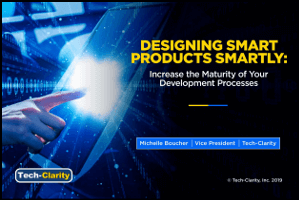How can companies mature their processes for designing smart products?
Tech-Clarity’s eBook, Designing Smart Products Smartly: Increase the Maturity of Your Development Processes, explores this question. The combination of mechanics, electronics and software into today’s smart products have made them more responsive, adaptable, interconnected and portable than ever before. Incidentally, with customers expecting this type of technology in their products, the growth of smart products will not abate. Though smart products can create opportunities, they also introduce new challenges and complexity. To overcome these challenges, companies need to mature their development processes. This eBook reveals the steps manufacturers can take to mature their processes for designing smart products.
Please enjoy the summary* below. For the full research, please visit our sponsor Dassault Systèmes (registration required).
Table of Contents
- Improve Smart Product Development Maturity
- Define the Target
- Plan the Product
- Validate Early and Often
- Design by Discipline and Validate to Interfaces
- Effectively Manage Change
- Enable an Integrated Lifecycle View
- Conclusions and Recommendations
- Acknowledgment
Improve Smart Product Development Maturity
The Opportunities for Smart Products
Customers in nearly every industry find smart products compelling. It’s hard to compete with a car that drives and parks itself or a clothes washer that senses and adjusts to water conditions, fabric types, and dirt levels and schedules service when needed. Likewise, a medical device that monitors patient health and notifies a doctor when needed offers significant value. Benefits will increase even further as smart products become more aware and communicative as companies adopt strategies to support the Internet of Things (IoT) and technologies like 5G create even more opportunity for connectivity.
 But There Are Challenges
But There Are Challenges
However, the advantages of smart products come at a cost. Developing complex, intelligent products brings inherent complexity. Multiple design disciplines must synchronize their work across different design life cycles. Multiple configuration options add even more complexity. Tech-Clarity research identifies several challenges created by increased complexity, but more importantly shows there can be significant, negative business impact (see graph). [1]
To overcome these challenges, companies need to raise the maturity of how they develop smart products. Fortunately, our research shows that better processes and enabling technology improve results through the use of a platform for integration, visibility, and traceability for smart product development. Digital transformation is a large piece of making these practices a success and enabling technologies such as the cloud, platforms, and modern design tools can make adoption easier. This paper outlines a number of tangible steps to improve the development of smart products with proven best practices, technology, and digital transformation.
Conclusions
Create a Competitive Advantage
To beat competitors with smart innovations, companies must raise the maturity of their development processes and tools. This report suggests best practices for requirements management, systems design, simulation, interface management, and change management. There are others as well, but these processes are proven and can provide significant value today.
 In addition to best practices, companies should implement a lifecycle-oriented platform to enable a cohesive, transparent product development process across disciplines. These solutions allow companies to implement best practices to take advantage of the compelling benefits of smart products without suffering from costly, negative impacts to quality and time-to-market.
In addition to best practices, companies should implement a lifecycle-oriented platform to enable a cohesive, transparent product development process across disciplines. These solutions allow companies to implement best practices to take advantage of the compelling benefits of smart products without suffering from costly, negative impacts to quality and time-to-market.
Recommendations
Based on industry experience and research for this report, Tech-Clarity offers the following recommendations:
- Follow proven best practices for developing smart products:
- Create a single source of truth for requirements
- Plan the product starting with architecture and develop a system model
- Use multi-physics simulation early and often at both the system and component level to optimize and validate the design
- Develop a common product definition with interfaces
- Manage change by starting with an impact analysis across all disciplines
- Leverage product innovation platforms to create an integrated lifecycle view
- Implement the right tools to enable design, including simulation and systems design tools
- Leverage lifecycle-oriented systems to integrate the various processes, people, and deliverables required to efficiently develop high quality, smart products.
[1] Boucher, Michelle, “Transformational Product Design,“ Tech-Clarity, 2017
*This summary is an abbreviated version of the research and does not contain the full content. A link to download the full research is available above.
If you have difficulty obtaining a copy of the research, pleasecontact us.

